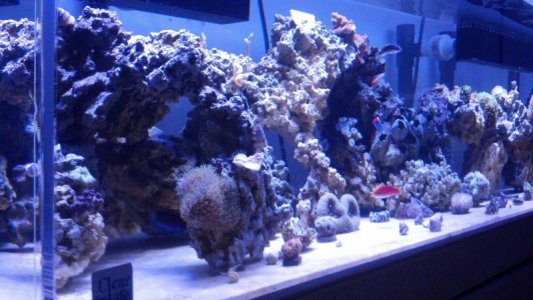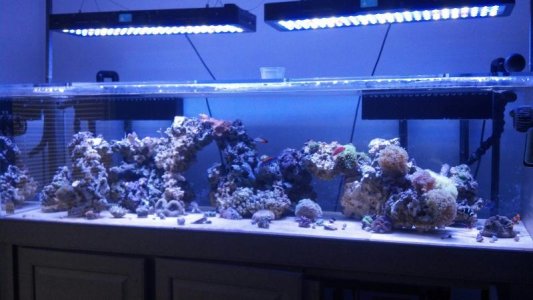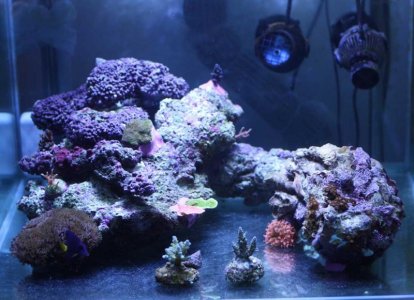You are using an out of date browser. It may not display this or other websites correctly.
You should upgrade or use an alternative browser.
You should upgrade or use an alternative browser.
Thinking of Going BB, Whats Your Experience?
- Thread starter ChadRaay86
- Start date
Maybe too late to chime in but IMO if you don't have a "real" DSB (very deep, which will likely go bad after several years) or a shallow sandbed that you can regularly clean, including under rocks, you will eventually run into PO4 issues. I had issues about 2 years after setting up my first reef tank around 12 years ago. I removed the sanded and kept my subsequent tanks BB for the next 11 years or so before getting out for a while. IMO BB is much easier to take care of.
hth, Chris
hth, Chris
Newbie Aquarist
Reefing is my middle name
BB all the way!
Great tank. What type of lights are you running? Where do you keep your parameters?
ChadRaay86
New member
After the rearrange my phosphates are .46Then again, the phosphates in my live rock holding tank were over .65! I'm going to dose some lanthanum chloride to bring it down in the near term, but I think its mainly just due to me stirring everything up...
I was really hoping for better results, but maybe I'll get those with tomorrow's test results. If not, I'll battle for a few more weeks, reevaluate and pull out the sand. After seeing all of the organics in the sand yesterday, I'm convinced that could be it...
Phosphates are at .41 today, so they're coming down, slowly
ChadRaay86
New member
Phosphates are at .41 today, so they're coming down, slowly
.33, still getting better. Hoping for under .15 tomorrow as I have some colonies that need to go in...
AcroporAddict
There is no substitute.
.33, still getting better. Hoping for under .15 tomorrow as I have some colonies that need to go in...
What are you using to test for phosphates? I am trying to decide on a Hanna checker or one of their more expensive photometers. Hate to admit it, but I have never tested my water for phosphates. I have just always used GFO.
ChadRaay86
New member
I use the hanna checker, the phosphate one (not phosphorous, which is better apparently). Its easy and accurate enough for me.
I wouldn't say there's a need to check it with the way your tank looks. If things begin to decline over time, I'd imagine it could be residual phosphates, but as long as your nutrient export is good enough you'll probably never have an issue. Especially with six MP-60s!
I wouldn't say there's a need to check it with the way your tank looks. If things begin to decline over time, I'd imagine it could be residual phosphates, but as long as your nutrient export is good enough you'll probably never have an issue. Especially with six MP-60s!
ChadRaay86
New member
.36 today 
Epicreefer
New member
I have had bare bottom and up to 2" of sand on several tanks. I wouldn't say one is better than the other but I have always had the best results with a coarse,2-5mm, sand bed around 1". It has probably been due to a lot of factors but I think if you have sand you need to gravel vacuum it every few months minimum. In general I prefer the sand bed look and to me it adds some stability. Nutrient levels I strive for are detectable nitrate, that means any color(0.2) to 5-10ppm nitrate with the salifert test kit. And a minimum of 0.03 phosphate. I turn on the gfo reactor when I get to 0.1 or 0.05 if I'm having algae issues, and off at .02-3. Without enough flow BB or not won't help, you need to get the detritus up off the floor for export with BB or it will just collect in a corner, and higher flow will keep it from settling into the sand. Personally I like more smaller power heads to fewer larger ones. More directions of flow reduces dead spots and smaller power heads reduces the extra high flow areas that corals tissue tears and can't survive.
For po4 removal change gfo every week, but only use around .25-.5 ml a gallon and push a lot of flow through it, more than usual. Put the output tube in the filter sock to remove the dust generated from the grinding of high flow. This should get your Po4 down the fastest with gfo, for lanthanum chloride a little, like 1ml for your 300g, twice a day is good and finish off at around 0.10 maybe a bit lower.
As far as Hanna checkers go, I prefer to go by the phosphate test kit. I have gotten readings of 0.00 with the phosphate and 40ppb with the phosphor, around 0.12 phosphate when converted. This is about where my tank stays with a lot of macro growth in the sump pulling out the po4 I presume. They read different kinds of phosphorus that react differently with corals. I know it's kind of weird and I don't try to figure it out anymore... I just try to use the same test kits and run at a consistent level and the po4 readings are more stable, while phosphor seems to rise with water top off over time. It seems to be in my top off water and not get used up by my macro algae. Also I have found if you do a lot of testing, like I did for a while on a dozen tanks a week, you want to buy your reagents in bulk, like 4-8 packs at a time, so they are all from the same batch. I have seen inconsistencies from different lot numbers on the same tank at the same time. Multiple tests from the same lot number read consistent but there was a big difference from one lot to the other.
For po4 removal change gfo every week, but only use around .25-.5 ml a gallon and push a lot of flow through it, more than usual. Put the output tube in the filter sock to remove the dust generated from the grinding of high flow. This should get your Po4 down the fastest with gfo, for lanthanum chloride a little, like 1ml for your 300g, twice a day is good and finish off at around 0.10 maybe a bit lower.
As far as Hanna checkers go, I prefer to go by the phosphate test kit. I have gotten readings of 0.00 with the phosphate and 40ppb with the phosphor, around 0.12 phosphate when converted. This is about where my tank stays with a lot of macro growth in the sump pulling out the po4 I presume. They read different kinds of phosphorus that react differently with corals. I know it's kind of weird and I don't try to figure it out anymore... I just try to use the same test kits and run at a consistent level and the po4 readings are more stable, while phosphor seems to rise with water top off over time. It seems to be in my top off water and not get used up by my macro algae. Also I have found if you do a lot of testing, like I did for a while on a dozen tanks a week, you want to buy your reagents in bulk, like 4-8 packs at a time, so they are all from the same batch. I have seen inconsistencies from different lot numbers on the same tank at the same time. Multiple tests from the same lot number read consistent but there was a big difference from one lot to the other.
I love BB!!!
after a 4 year break i have a new one!
Here is my 2008 BB

This was my 2011 tank that had to go because of time constraints I was gutted as I had spent so much time and money planning it and putting it into action, but reefing back in the UK was too much hard work.

and my latest tank

apologies for hijacking.
after a 4 year break i have a new one!
Here is my 2008 BB
This was my 2011 tank that had to go because of time constraints I was gutted as I had spent so much time and money planning it and putting it into action, but reefing back in the UK was too much hard work.
and my latest tank
apologies for hijacking.
Attachments
Last edited:
sahin
Ultimate Reefer
I love BB!!!
after a 4 year break i have a new one!
Here is my 2008 BB

This was my 2011 tank that had to go because of time constraints I was gutted as I had spent so much time and money planning it and putting it into action, but reefing back in the UK was too much hard work.

and my latest tank

apologies for hijacking.
New tank looks nice! :thumbsup: I remember your from years back. Nice to see you're back to reefkeeping. You need to start a build thread.
ChadRaay86
New member
I have had bare bottom and up to 2" of sand on several tanks. I wouldn't say one is better than the other but I have always had the best results with a coarse,2-5mm, sand bed around 1". It has probably been due to a lot of factors but I think if you have sand you need to gravel vacuum it every few months minimum. In general I prefer the sand bed look and to me it adds some stability. Nutrient levels I strive for are detectable nitrate, that means any color(0.2) to 5-10ppm nitrate with the salifert test kit. And a minimum of 0.03 phosphate. I turn on the gfo reactor when I get to 0.1 or 0.05 if I'm having algae issues, and off at .02-3. Without enough flow BB or not won't help, you need to get the detritus up off the floor for export with BB or it will just collect in a corner, and higher flow will keep it from settling into the sand. Personally I like more smaller power heads to fewer larger ones. More directions of flow reduces dead spots and smaller power heads reduces the extra high flow areas that corals tissue tears and can't survive.
For po4 removal change gfo every week, but only use around .25-.5 ml a gallon and push a lot of flow through it, more than usual. Put the output tube in the filter sock to remove the dust generated from the grinding of high flow. This should get your Po4 down the fastest with gfo, for lanthanum chloride a little, like 1ml for your 300g, twice a day is good and finish off at around 0.10 maybe a bit lower.
As far as Hanna checkers go, I prefer to go by the phosphate test kit. I have gotten readings of 0.00 with the phosphate and 40ppb with the phosphor, around 0.12 phosphate when converted. This is about where my tank stays with a lot of macro growth in the sump pulling out the po4 I presume. They read different kinds of phosphorus that react differently with corals. I know it's kind of weird and I don't try to figure it out anymore... I just try to use the same test kits and run at a consistent level and the po4 readings are more stable, while phosphor seems to rise with water top off over time. It seems to be in my top off water and not get used up by my macro algae. Also I have found if you do a lot of testing, like I did for a while on a dozen tanks a week, you want to buy your reagents in bulk, like 4-8 packs at a time, so they are all from the same batch. I have seen inconsistencies from different lot numbers on the same tank at the same time. Multiple tests from the same lot number read consistent but there was a big difference from one lot to the other.
Wow! Thanks for the great write up. I currently have some pretty fine stuff in my tank, but I totally get your point about course sand. If I do pull the sand out and decide BB isn't for me, I will go with a much more coarse sand. At this point I think I might need to pull the sand out to get all of the bound up phosphates out of my sand.
Flow was also a big problem for me. I underestimated my need and the tank struggled because of it. Luckily, I have just invested in some MP-60s and MP-40s so I think flow might not be an issue for much longer
I'm not usually a big tester, but I will be until I notice my phosphates come down to a more acceptable level. .03 or better
I may give it another week because with midterms I don't have a lot of time right now, but I really really don't want to lose this awesome bonsai colony I just got for next to nothing
250G
New member
compelling?
The places I have been diving the sand isn't very close to the corals at all. I don't think "natural" is a compelling argument.
Coral looks good but my PO4 is around .10-.30 on any given day.
I don't see the problem.
After the rearrange my phosphates are .46Then again, the phosphates in my live rock holding tank were over .65! After seeing all of the organics in the sand yesterday, I'm convinced that could be it...
The problem clearly isn't the sand, it is po4 coming from the rock. I think you have figured that out. :thumbsup:
We often point our fingers at things being a problem in this hobby when they probably are not. If sand were this massive nutrient sink then everyone who has sand would have a problem, yet that isn't the case. There are plenty of tanks with sand that has never been "cleaned" and these tanks do not have issues. Though it is possible to have issues related to sand, it is also possible to have issues without sand.
We often freak out over nutrient levels, when they may not be an issue at all. There are far more issues that arise from people striving for nutrient poor systems than there are for people who don't stress out about it. I have run DSB, BB and SSB and found very little difference in any of them as far as no3 and po4 are concerned. What I have noticed (and is reasonable) is that with sand you also get more worm and pod growth, which is a good thing. With BB I used more GFO and VSV to keep things where I wanted them, but it was not a problem. (I suspect this is also because there was significantly less sponges, worms, stars and pods.)
On my old 125, I had 2-4" of sand, and it was never cleaned, mainly because I could not clean it, too much rock and coral in the way. For years it just collected "junk" yet it was the healthiest tank I have ever had. Massive amounts of pods, micro stars, worms and sponges is something I did have. The sand debate is a silly one, you can run a healthy tank with or without, it just becomes a preference and what you are comfortable with.
ChadRaay86
New member
I'm not chasing numbers so much as chasing the right combination for nutrient export. I wasn't doing enough before and it was evident. By monitoring and lowering my phosphates, I'll know that I'm at least on the right track.
I would tend to agree with your bottom point but with 60 percent of my rock being "phosphate free" at the moment why would my phosphates be at .30 when they were riding at a consistent .16-.22? I've given it all a week to settle down, but my phosphates are still high. I have a big bioload and will by no means ever think of seeking to have a ULNS as I think they are unstable and corals look bad. Hopefully my phosphates come into line soon and I can keep up my new maintenance schedule to keep it all in check.
My last resort will be to pull the sand temporarily and possibly replace it with new more course stuff.
Thanks for your insight!
I would tend to agree with your bottom point but with 60 percent of my rock being "phosphate free" at the moment why would my phosphates be at .30 when they were riding at a consistent .16-.22? I've given it all a week to settle down, but my phosphates are still high. I have a big bioload and will by no means ever think of seeking to have a ULNS as I think they are unstable and corals look bad. Hopefully my phosphates come into line soon and I can keep up my new maintenance schedule to keep it all in check.
My last resort will be to pull the sand temporarily and possibly replace it with new more course stuff.
Thanks for your insight!
Similar threads
- Replies
- 0
- Views
- 1K
- Replies
- 0
- Views
- 1K







